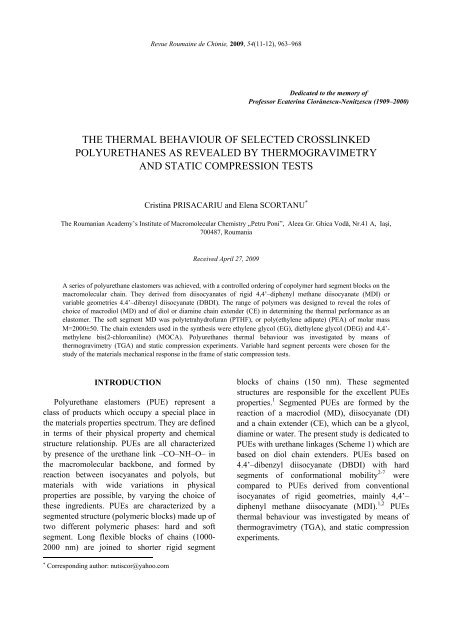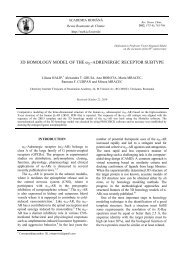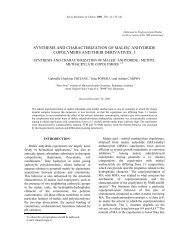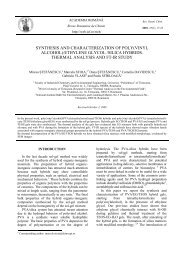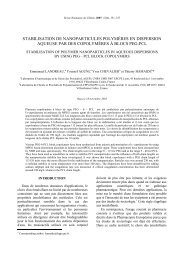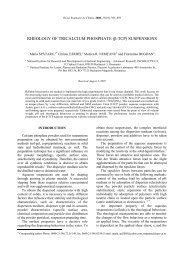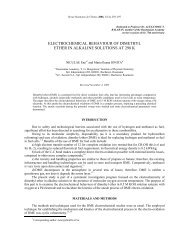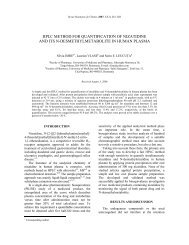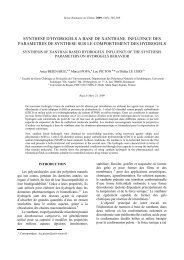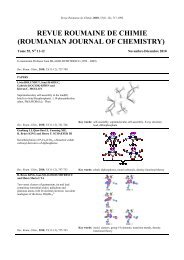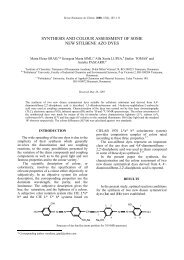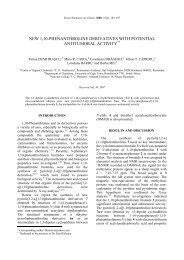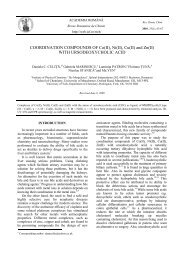the thermal behaviour of selected crosslinked polyurethanes as ...
the thermal behaviour of selected crosslinked polyurethanes as ...
the thermal behaviour of selected crosslinked polyurethanes as ...
- No tags were found...
You also want an ePaper? Increase the reach of your titles
YUMPU automatically turns print PDFs into web optimized ePapers that Google loves.
Revue Roumaine de Chimie, 2009, 54(11-12), 963–968Dedicated to <strong>the</strong> memory <strong>of</strong>Pr<strong>of</strong>essor Ecaterina Ciorănescu-Nenitzescu (1909–2000)THE THERMAL BEHAVIOUR OF SELECTED CROSSLINKEDPOLYURETHANES AS REVEALED BY THERMOGRAVIMETRYAND STATIC COMPRESSION TESTSCristina PRISACARIU and Elena SCORTANU *The Roumanian Academy’s Institute <strong>of</strong> Macromolecular Chemistry „Petru Poni”, Aleea Gr. Ghica Vodă, Nr.41 A, Iaşi,700487, RoumaniaReceived April 27, 2009A series <strong>of</strong> polyurethane el<strong>as</strong>tomers w<strong>as</strong> achieved, with a controlled ordering <strong>of</strong> copolymer hard segment blocks on <strong>the</strong>macromolecular chain. They derived from diisocyanates <strong>of</strong> rigid 4,4’–diphenyl methane diisocyanate (MDI) orvariable geometries 4.4’–dibenzyl diisocyanate (DBDI). The range <strong>of</strong> polymers w<strong>as</strong> designed to reveal <strong>the</strong> roles <strong>of</strong>choice <strong>of</strong> macrodiol (MD) and <strong>of</strong> diol or diamine chain extender (CE) in determining <strong>the</strong> <strong>the</strong>rmal performance <strong>as</strong> anel<strong>as</strong>tomer. The s<strong>of</strong>t segment MD w<strong>as</strong> polytetrahydr<strong>of</strong>uran (PTHF), or poly(ethylene adipate) (PEA) <strong>of</strong> molar m<strong>as</strong>sM=2000±50. The chain extenders used in <strong>the</strong> syn<strong>the</strong>sis were ethylene glycol (EG), diethylene glycol (DEG) and 4,4’-methylene bis(2-chloroaniline) (MOCA). Polyurethanes <strong>the</strong>rmal <strong>behaviour</strong> w<strong>as</strong> investigated by means <strong>of</strong><strong>the</strong>rmogravimetry (TGA) and static compression experiments. Variable hard segment percents were chosen for <strong>the</strong>study <strong>of</strong> <strong>the</strong> materials mechanical response in <strong>the</strong> frame <strong>of</strong> static compression tests.INTRODUCTION ∗Polyurethane el<strong>as</strong>tomers (PUE) represent acl<strong>as</strong>s <strong>of</strong> products which occupy a special place in<strong>the</strong> materials properties spectrum. They are definedin terms <strong>of</strong> <strong>the</strong>ir physical property and chemicalstructure relationship. PUEs are all characterizedby presence <strong>of</strong> <strong>the</strong> urethane link –CO–NH–O– in<strong>the</strong> macromolecular backbone, and formed byreaction between isocyanates and polyols, butmaterials with wide variations in physicalproperties are possible, by varying <strong>the</strong> choice <strong>of</strong><strong>the</strong>se ingredients. PUEs are characterized by <strong>as</strong>egmented structure (polymeric blocks) made up <strong>of</strong>two different polymeric ph<strong>as</strong>es: hard and s<strong>of</strong>tsegment. Long flexible blocks <strong>of</strong> chains (1000-2000 nm) are joined to shorter rigid segmentblocks <strong>of</strong> chains (150 nm). These segmentedstructures are responsible for <strong>the</strong> excellent PUEsproperties. 1 Segmented PUEs are formed by <strong>the</strong>reaction <strong>of</strong> a macrodiol (MD), diisocyanate (DI)and a chain extender (CE), which can be a glycol,diamine or water. The present study is dedicated toPUEs with urethane linkages (Scheme 1) which areb<strong>as</strong>ed on diol chain extenders. PUEs b<strong>as</strong>ed on4.4’–dibenzyl diisocyanate (DBDI) with hardsegments <strong>of</strong> conformational mobility 2-7 werecompared to PUEs derived from conventionalisocyanates <strong>of</strong> rigid geometries, mainly 4,4’–diphenyl methane diisocyanate (MDI). 1,2 PUEs<strong>the</strong>rmal <strong>behaviour</strong> w<strong>as</strong> investigated by means <strong>of</strong><strong>the</strong>rmogravimetry (TGA), and static compressionexperiments.∗ Corresponding author: nutiscor@yahoo.com
964 Cristina Prisacariu and Elena ScortanuORNHCORThe urethane linkageOOCON CHCH 2 2N CHHOCH 2 CH 2The urethane linkage in a polyurethane el<strong>as</strong>tomerScheme 1 – Flexible and rigid domains in a polyurethane el<strong>as</strong>tomer.RESULTS AND DISCUSSION1. PUEs ThermogravimetryThermogravimetric (TGA) experiments weremade by a MOM–Budapest instrument typeDerivatograph, System: F. Paulik, I. Paulik, L.Erdley, with a heating rate <strong>of</strong> 12 °C/min till 600°C, in air. As seen in Figure 1, and in Table 1 also,<strong>the</strong> presence <strong>of</strong> <strong>the</strong> different DTG maxima showthat <strong>the</strong> degradation process is made up bysubsequent processes which are different from aPUE to ano<strong>the</strong>r. The TGA analyses showed that<strong>the</strong> dibenzyl-b<strong>as</strong>ed materials start to decompose athigher temperatures (up to 290 °C) <strong>as</strong> compared tosimilar materials derived from conventionalcommercial diisocyanates with rigid structures,(Figure 1). As observed, <strong>the</strong> limits <strong>of</strong> <strong>the</strong> <strong>the</strong>rmalstability for <strong>the</strong> three types <strong>of</strong> PUE were closed <strong>as</strong>follows: PUE with CE MOCA (290 °C) > PU withCE DEG (280 °C) > commercial Adiprene L 100(100 – 270 °C). As shown in Figure 2, TGAanalyses were also made for a series <strong>of</strong>intermediates which were syn<strong>the</strong>sized with twoidentical functional groups situated in differentrings: 2,2’- DBDI, 2,4’-DBDI and 4,4’-DBDI. 3 For<strong>the</strong>se structures <strong>the</strong> melting point <strong>of</strong> <strong>the</strong> polymerw<strong>as</strong> 312 °C and <strong>the</strong> initial decompositiontemperature <strong>of</strong> <strong>the</strong> polymer w<strong>as</strong> 220 °C.Table 1Thermogravimetric data <strong>of</strong> PUE-Adiprene L 100, PU with CE DEG and PUE with CE MOCAPU T a 0 (°C) T a 5 (°C) T a 10 (°C)bMaxDTG 1bMaxDTG 2PUE-Adiprene L 100 270 305 325 405 –PU with CE DEG 280 315 320 334 430PUE with CE MOCA 290 322 337 366 415a) T 0 , T 5 , and T 10 represent <strong>the</strong> start <strong>of</strong> degradation, respectively, <strong>the</strong> temperatures <strong>of</strong> 5% and 10% weight loss. T(°C) areexpressed <strong>as</strong> Celsius degrees. (Chimia generala, C. D. Nenitescu, Editura didactica si pedagogica, Bucuresti, 1972)b) MaxDTG represents <strong>the</strong> peak(s) <strong>of</strong> DTG curves corresponding on <strong>the</strong> inflexion points <strong>of</strong> TG curves <strong>as</strong> determined by TGA.Experimental Methods in Polymer Chemistry, Physical Principles and Applications, Jan F. Rabek; A Wiley-IntersciencePublication, John Wiley & Sons, New York, 1980.2. MECHANICAL TESTS.PUEs STATIC COMPRESSIONThe interaction between <strong>the</strong> chemical structureand compression properties in c<strong>as</strong>ting PUEs and<strong>the</strong> influence <strong>of</strong> <strong>the</strong> specimen shape on <strong>the</strong> YoungModulus (E) w<strong>as</strong> followed. PUE specimen shapefactor (θ) w<strong>as</strong> expressed <strong>as</strong> <strong>the</strong> ratio between <strong>the</strong>PUE specimen charged area and <strong>the</strong> sum <strong>of</strong> <strong>the</strong>free are<strong>as</strong> <strong>of</strong> <strong>the</strong> specimen. The dependence E = f(θ) w<strong>as</strong> discussed. At room temperatures <strong>the</strong> values<strong>of</strong> <strong>the</strong> PUE Young Moduli at a 20% compression(E 20 ) were comparable between <strong>the</strong> DBDI-b<strong>as</strong>edpolymers and different conventional <strong>polyurethanes</strong>derived from MDI or o<strong>the</strong>r cl<strong>as</strong>sical DI. At highertemperatures (up to destruction compression at 80°C) <strong>the</strong> DBDI-b<strong>as</strong>ed PUEs displayed a betterel<strong>as</strong>tomeric compression behavior, which w<strong>as</strong>revealed by higher E 20 values in comparison to <strong>the</strong>cl<strong>as</strong>sical PUE moduli.
Crosslinked <strong>polyurethanes</strong> 965Fig. 1 – TGA and DTG curves for 3 PUEs:(―) commercial PUE-Adiprene L 100;(---) c<strong>as</strong>ted dibenzyl-b<strong>as</strong>ed PUE derived frompolyester MD (DBDI: PEA 2000 :DEG, I=110); (····)c<strong>as</strong>ted dibenzyl-b<strong>as</strong>ed PUE with poly-e<strong>the</strong>r MDand 4,4’-methylene bis(2-chloro-aniline) (MOCA):(DBDI:PTHF 1000 : MOCA).Fig. 2 – TGA curves for PUEs b<strong>as</strong>ed CE ethylene glycol (EG), and DBDIisomers, 2,2’-DBDI (─), 2,4-DBDI (- · -) and 4,4’-DBDI (- - ).Shown in Table 2 is <strong>the</strong> influence <strong>of</strong> <strong>the</strong> PUEhard segment concentration on <strong>the</strong> residualelongation (ε r ) and Young Modulus at a 20%polymer compression (E 20 ) on employing twodifferent chain extenders, i.e. EG and DEG and <strong>the</strong>macrodiol PEA. The differences between <strong>the</strong><strong>the</strong>rmal <strong>behaviour</strong> <strong>of</strong> <strong>the</strong>se materials could beexplained in terms <strong>of</strong> <strong>the</strong> chain extender–diisocyanate couple: <strong>the</strong> couple EG-DBDI where<strong>the</strong> hard segments were observed to crystallize <strong>as</strong>compared to <strong>the</strong> diisocyanate couple DEG-DBDIwhere <strong>the</strong> hard segment do not crystallize. 2,3 Asseen in Table 2, in general all <strong>the</strong> studied DBDIb<strong>as</strong>ed<strong>polyurethanes</strong> showed a good compressionbehavior which w<strong>as</strong> revealed by small values <strong>of</strong><strong>the</strong> compression sets (2-3%).When <strong>the</strong> materials were tested to compressionunder extreme conditions (313 MPa) and t°=80 °C(<strong>the</strong> CD c<strong>as</strong>e in Table 2), <strong>the</strong>re were observedhigher compression set data. The best compressionbehavior w<strong>as</strong> found for a DBDI-b<strong>as</strong>ed materialwith DEG 50, i.e. where a hard segmentpercentage (50 wt %) w<strong>as</strong> adopted, when itobtained a smaller compression set ε r = 6.2% <strong>as</strong>compared to o<strong>the</strong>r commercial PUEs likeContinental and Vulkollan 30, 1 where ε r rangedbetween higher values from 12.5% (PUE typeContinental) to 25 ÷ 37.5% (PUE type Vulkollan25) and 9.1 (PUE type Vulkollan 30). It should bementioned that <strong>the</strong> better mechanical <strong>behaviour</strong> <strong>of</strong><strong>the</strong> DBDI–b<strong>as</strong>ed PUEs under CD conditions couldbe obtained by consolidating <strong>the</strong> macromolecularnetwork achieved by adding small quantities (1%)<strong>of</strong> trifunctional agents (TMP). With regard to <strong>the</strong>Young Modulus dependence on <strong>the</strong> PUE structure,<strong>the</strong> following general remaks could be made: (a)<strong>the</strong> nature <strong>of</strong> <strong>the</strong> CE influenced <strong>the</strong> E 20 values in<strong>the</strong> following order DEG < EG < BG < MOCA.The DBDI b<strong>as</strong>ed materials derived from chainextender MOCA displayed higher E 20 Modulusvalues even at 80 °C; (b) <strong>the</strong> nature <strong>of</strong> <strong>the</strong> s<strong>of</strong>tsegment (MD) influenced <strong>the</strong> E 20 Modulusvariation degree with incre<strong>as</strong>ing <strong>the</strong> temperature.
966 Cristina Prisacariu and Elena ScortanuTable 2Influence <strong>of</strong> <strong>the</strong> hard segment concentration on <strong>the</strong> residual deformation (ε r ) and Young Modulus at a 20%compression (E 20 ) and variable temperatures, for a series <strong>of</strong> DBDI-b<strong>as</strong>ed PUEs obtained with DEG andmacrodiol PEA; (CM) - compression under medium conditions; (CD) - distruction compression.CE type DEG hardsegment percentage (wt %)T° Immediate ε r ,[%]ε r after30 min, [%]ε r after24 hrs, [%]E 20[MPa]20 3.73 2.74 2.24 31.2CM 50 2.73 2.48 2.48 21.2DEG 3280 - - - -20 28.36 12.69 11.2CD 50 12.03 6.02 6.0220 5.29 2.52 2.52 22.8DEG 40 CM 50 6.28 4.52 4.52 20.080 6.00 5.00 5.0 13.720 5.96 3.23 2.73 47.6CM 80 3.74 3.49 3.49 29.6DEG 4720 12.5 1.56 1.56CD 50 - - -80 19.69 18.11 18.920 20.5 2.75 2.50 38.1CM 50 7.58 6.6 6.36 31.580 4.34 4.10 3.80 30.0DEG 5020 5.10 3.06 2.04CD 50 9.84 8.20 8.0080 11.43 9.52 9.5220 3.10 2.26 1.75 29.1CM 50 4.25 3.75 3.75 27.7DEG 6080 5.00 4.75 4.75 24.320 5.10 3.06 2.04CD 50 9.84 8.20 8.0080 11.43 9.52 9.5220 2.49 0.50 0.5 15.9DEG 27 CM 50 2.48 2.23 1.99 15.2CD – distructive compression at 313 MPa and t° = 80 °C; CM – medium compression at t° = 20 ÷ 80 °C.Table 3Influence <strong>of</strong> <strong>the</strong> nature <strong>of</strong> MD on ε r and E 20 for a series <strong>of</strong> PUEs b<strong>as</strong>ed on macrodiol PTHF, at variable temperatures and two shapefactor values: (ϑ = 0.25) for PUE compression under medium conditions (CM) and (ϑ = 0.35) for distruction compression (CD)CE type BG hard segment percentage t° Immediate ε r ,ε r afterε r after E 20 [MPa](wt %)[%]30 min, [%] 24 hrs, [%]20 4.3 2.5 2.5 44.0BG 32CM 50 4.3 3.8 3.8 42,.80 1.8 1.8 1.8 34.820 4.8 3.3 2.8 35.2CM 50 1.8 1.8 1.8 33.7BG 3780 3.8 3.8 3.3 37.8CD 20 33.3 21 17.550 28.8 28 2880 36.8 35.2 35,2CE type BG and DEG hard segmentpercentage (wt %)BG 40CMCDT° Immediate ε r ,ε r afterε r after E 20 [MPa][%]30 min, [%] 24 hrs, [%]20 4.3 2.0 2.0 44.850 1.5 1.5 1.5 42.980 3.25 0.5 0.5 41.120 25.4 17.2 1450 29.1 28.2 28.280 42.0 42.0 42.0
Crosslinked <strong>polyurethanes</strong> 967DEG 40DEG 47CMCDCMCD20 4.3 2.5 2.5 31.650 6.1 5.4 5.4 32.180 2.3 0.3 0.3 13.020 19.6 15.2 12.550 13.3 10.8 10.880 16.7 13.3 13.320 4.3 2.5 2.5 35.050 3.5 2.3 2.3 35.880 1.8 1.6 1.6 10.520 18.0 14.0 10.050 15.8 12.5 12.580 17.0 15.3 15.3CD: distructive compression at 313 MPa and t° = 80 °C; CM: medium compression at t° = 20 ÷ 80 °C.In Table 3 <strong>the</strong>re are depicted <strong>the</strong> compressiondata achieved for a series <strong>of</strong> materials employedwith <strong>the</strong> macrodiol PTHF. Two chain extenderswere used, 1,4-butanediol (BG) and diethyleneglycol (DEG). The hard segment percent w<strong>as</strong>varied from 32% to 40% in <strong>the</strong> c<strong>as</strong>e <strong>of</strong> PUEs withBG, and from 40 % to 47% in <strong>the</strong> c<strong>as</strong>e <strong>of</strong> <strong>the</strong>polymers achieved with DEG. The highestmodulus w<strong>as</strong> observed for a DBDI b<strong>as</strong>ed polymerderived from BG 40 wt%. 3 There is directproportionality between <strong>the</strong> modulus and <strong>the</strong> hardsegment weight percent. The enhance <strong>of</strong> <strong>the</strong> hardsegment percent determined an incre<strong>as</strong>e <strong>of</strong> <strong>the</strong>Young Modulus values. As expected <strong>the</strong> YoungModulus data decre<strong>as</strong>ed with incre<strong>as</strong>ing <strong>the</strong>temperature.EXPERIMENTAL PARTMaterials syn<strong>the</strong>sisThe following general procedure w<strong>as</strong> undertaken: 100g(0.05 mol <strong>of</strong> macrodiol polyethylene adipate (PEA) orpolytetrahydr<strong>of</strong>uran (PTHF) respectively w<strong>as</strong> dehydratedunder mixing at 110 °C and vacuum (< 1mm Hg) for 2 hours.52.8g (0.2 mol) <strong>of</strong> DBDI for <strong>the</strong> PUE D type or respectively,50g (0.2 mol) <strong>of</strong> MDI in <strong>the</strong> c<strong>as</strong>e <strong>of</strong> PUE M type <strong>of</strong> el<strong>as</strong>tomer,w<strong>as</strong> added at once under intense mixing to <strong>the</strong> anhydrousmacrodiol, and vacuum w<strong>as</strong> restored. After 30 minutes <strong>of</strong>mixing under vacuum at 100 °C <strong>the</strong> temperature w<strong>as</strong> reducedto 90 °C and vacuum w<strong>as</strong> removed. It obtained a prepolymerwith final NCO groups in mixture with <strong>the</strong> excess <strong>of</strong>isocyanate. Then 8.18g (0.1318 mol) ethylene glycol (EG)were added at once under rapid stirring. For a series <strong>of</strong> PUEs,EG w<strong>as</strong> replaced with diethylene glycol (DEG). The mixingw<strong>as</strong> continued for maximum 30-40 seconds. The “pot life” <strong>of</strong><strong>the</strong> mixture w<strong>as</strong> between 3 and 10 minutes depending on <strong>the</strong>PUE structure. During this time <strong>the</strong> liquid mixture w<strong>as</strong> c<strong>as</strong>tonto closed teflonated moldings pre-heated at 90 °C so <strong>as</strong> toavoid <strong>the</strong> interface <strong>of</strong> air humidity during <strong>the</strong> cure process. In<strong>the</strong> c<strong>as</strong>t <strong>of</strong> open molding <strong>the</strong> presence <strong>of</strong> air usually leads tosome perturbing uncontrolled and inhomogeneousenhancement <strong>of</strong> <strong>the</strong> mechanical properties. For <strong>the</strong> cureprocess <strong>the</strong> closed moldings were maintained after c<strong>as</strong>ting at110 °C for 24 hours. After an additional time <strong>of</strong> 24 hours atroom temperature, <strong>the</strong> polymeric sheets representing anactive PUE oligomer with NCO final groups weredemoulded. Similarly, a series <strong>of</strong> polye<strong>the</strong>rurethanes b<strong>as</strong>edon DBDI and by using 4,4’-methylene-bis(2-chloroaniline)(MOCA) <strong>as</strong> chain extender were syn<strong>the</strong>sized and tested. 3 Themechanical properties were me<strong>as</strong>ured only after staying atambient conditions for at le<strong>as</strong>t two weeks. This time w<strong>as</strong>necessary to finish <strong>the</strong> postcure process 3 in <strong>the</strong> c<strong>as</strong>e <strong>of</strong> PUEsheets <strong>of</strong> 0.3 to 2 mm thick when <strong>the</strong> whole amount <strong>of</strong> NCOexcess group w<strong>as</strong> consumed in principal through <strong>the</strong> reactionwith <strong>the</strong> air humidity, leading to new urea group linkages.It w<strong>as</strong> shown 2,5 that PUEs with excellent mechanicalproperties were obtained when in <strong>the</strong> el<strong>as</strong>tomer syn<strong>the</strong>sis w<strong>as</strong>adopted a technique which uses a small excess <strong>of</strong> DI relativeto <strong>the</strong> total amount <strong>of</strong> <strong>the</strong> hydroxyl partners e.g. MD and CE.This DI excess h<strong>as</strong> to compensate <strong>the</strong> little secondary NCOgroup consumption produced by <strong>the</strong> some allophanate groupformation, which perturbs <strong>the</strong> desired stoichiometricalbalance between <strong>the</strong> OH and NCO group concentrationnecessary to achieve polymers with high molecular weights.In concordance with this technique a prepolymerobtained from <strong>the</strong> reaction between 1 mol <strong>of</strong> MD, e.g.polyethylene adipate (PEA) or polytetrahydr<strong>of</strong>uran (PTHF)and 2.64 to 4 moles <strong>of</strong> DI, w<strong>as</strong> reacted with a low moleculardiol <strong>as</strong> a CE taken in a quantity calculated so that in <strong>the</strong>product should remain <strong>the</strong>oretically an excess <strong>of</strong> unreactedNCO groups corresponding to an index I = 110 when I =([NCO] 100) / ([OH] MD + [OH] CE ) where [NCO] =equivalents <strong>of</strong> NCO groups from DI; [OH] MD = equivalents<strong>of</strong> OH groups from MD; [OH] CE = equivalents <strong>of</strong> OH groupsfrom CE.ThermogravimetryThermogravimetric (TGA) experiments were made in airby a MOM–Budapest instrument type Derivatograph,System: F. Paulik, I. Paulik, L. Erdley, with a heating rate <strong>of</strong>12 °C/min till 600 °C. In all <strong>the</strong> c<strong>as</strong>es <strong>the</strong> quantity <strong>of</strong> polymerused w<strong>as</strong> 50 mg polymer.Mechanical testsPUEs were subjected to compression tests at constantnominal strain-rate and temperatures ranging from 20 °C to80 °C. The data were obtained using a Schopper MZ GipTesting Machine, and a home-made hydraulic press whichw<strong>as</strong> reported elsewhere. 3 Test specimens for compressionexperiments were prepared <strong>as</strong> previously reported. 3
968 Cristina Prisacariu and Elena ScortanuCONCLUSIONSIn <strong>the</strong> present study, our approach h<strong>as</strong> been tostudy <strong>the</strong> structure–property relationship for awide range <strong>of</strong> <strong>polyurethanes</strong> <strong>of</strong> known andsystematically-varied composition, preparedunder well-defined conditions. The range <strong>of</strong>structures achieved w<strong>as</strong> widened, by inclusion <strong>of</strong><strong>the</strong> diisocyanate DBDI with an unusually largeconformational mobility. Two diol chainextenders (CE) were employed: ethylene glycol(EG) and diethylene glycol (DEG). Variable hardsegment percents were used. Several types <strong>of</strong>well-defined static compression tests were made:<strong>the</strong> stress-strain data were determined at constantand variable temperatures (20 °C – 90 °C), onproviding variable values <strong>of</strong> compression rangingbetween 5% - 40%. The influence <strong>of</strong> CE andShape Factor (θ) on <strong>the</strong> compression set andYoung modulus w<strong>as</strong> followed. For θ = 0.25 atroom temperature, Young modulus values werecomparable for <strong>the</strong> DBDI and MDI b<strong>as</strong>edmaterials, (10 ÷ 70 MPa). The compression setvalues varied between 0% ÷ 24 %, depending on<strong>the</strong> adopted type <strong>of</strong> CE (EG or DEG) and nature<strong>of</strong> <strong>the</strong> hard segment. In <strong>the</strong> c<strong>as</strong>e <strong>of</strong> compressiontests made at high temperatures (80 °C), <strong>the</strong>rewere observed higher Young modulus data for <strong>the</strong>materials with DBDI up to 45 MPa <strong>as</strong> comparedto 34.3 MPa for materials b<strong>as</strong>ed on isocyanates <strong>of</strong>rigid geometries. The mechanical properties <strong>of</strong>such materials were greatly enhanced by hardph<strong>as</strong>ecrystallinity. The particular DBDI b<strong>as</strong>edhard block components which display flexibilityspecifically affect modulus and hardness, and alsodetermine <strong>the</strong> upper use temperature by <strong>the</strong>irspecial ability to remain <strong>as</strong>sociated at elevatedtemperatures.REFERENCES1. C. Hepburn, Iranian J. Polym. Sci. Technol., 1992, 1,84-108.2. C. Prisacariu, R.H.Olley, A. Caraculacu, D.C. B<strong>as</strong>settand C.M. Martin, Polymer, 2003, 44, 5407-5421.3. C.P.Buckley, C. Prisacariu and A. Caraculacu,Euromech Colloquium and Workshop, Vienna, July,2002, 96-99.4. C.P.Buckley, C.Prisacariu and A. Caraculacu, 12thInternational Conference in Deformatiion, Yield andFracture <strong>of</strong> Polymers, 7-10 April, Cambridge, UK,2003, 349-352.5. C. Prisacariu, C.P. Buckley and A. Caraculacu, Polymer,2005, 46, 3884-3894.6. C. Prisacariu and E. Scortanu, Macromol. Symp., 2007,254, 153-159.7. C.P. Buckley, C. Prisacariu and A. Caraculacu, Polymer,2007, 48, 1388-1396.


